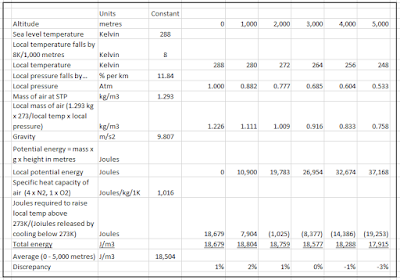Some of my posts drag on a bit before the conclusion, so this time I will do bullet points first (with links to skip down to the fuller explanation).
1) The traditional explanation, that the sun warms the Earth's surface; the surface warms the air above it is largely nonsense, if you bother thinking about it for a few minutes. To make matters worse, they never make it clear whether they mean warming by conduction, convection or radiation.Fuller explanation.
2) The actual explanation is that energy tries to spread out and equalise in all directions. The number of Joules in each m3 of the Earth's troposphere is actually the same. The air in 1 m3 at sea level has no potential energy but lots of heat energy. The air in 1 m3 higher up has less heat energy but more potential energy. The two amounts of energy (number of Joules) add up to the same. It does not matter whether you call it conduction, convection or radiation!Fuller explanation.
3) Some constants and formulae we have to accept as a given; we plug these into the workings; and work backwards to get the lapse rate that balances energy/volume (measured as Joules/m3). Constants, formulae and workings.
4) Conclusion: to get the energy/m3 to balance, the local temperatures of the atmosphere has to fall by 8C (or 8K) for every 1 km you go up. That's a bit more than the observed lapse rate of 6.5C, and a bit less than the 9.8C which Wiki says is the theoretical dry lapse rate. So I'm pretty happy with it for now.
5) How to set up hyperlinks within one web page, from ComputerHope.com.
-----------------------------------------
1) The traditional explanation is nonsense.
You're seven years old and your science teacher tells you that the Sun warms the earth surface; this warms the air above it; that warms the air above that etc. So the bottom layer is warmest and it gets colder the higher you go. So kids, she trills, that's why it's so cold at the top of Mt Everest or outside a jet plane.
Sounds plausible until you relate it to real life...
- there is a lapse rate at night, when the surface is not being warmed and it's actually cooling down faster than the air. Which is why you should have more layers underneath you than above you when sleeping in the open at night.
- there is a lapse rate, even when it's cloudy and the surface is not being warmed; the sun is hitting the clouds first. It's still colder above the clouds than below.
- the Sun (when it's shining) hits the top of Mt Everest with the same intensity as it hits land at sea level; but it doesn't warm it up nearly as much (immediate thought; because there is not as much air insulating it? But Miss, I thought a vacuum insulated better - i.e. conducts less heat - than air? But a vacuum allows heat to radiate more easily? All these are dead ends).
2) The actual explanation.
- I hope we all remember "Energy cannot be created or destroyed, it just transforms from one state to another". The sun sends us energy as light; plants use it to grow and they store chemical energy. You burn wood (stored chemical energy) in a power station and convert it to heat; that turns water to steam; steam gets converted to kinetic energy and water (again); the kinetic energy gets converted via magnetic to electrical energy. Which goes down the wires, through a filament in a bulb and becomes light energy and heat; the same as what we got from sun a long time ago.
- energy will choose whatever state enables it to spread out as quickly as possible for a given medium.
- heat will flow from warm to cold (speed depends on how good the medium insulates); photons will go from light to dark (which is why it takes them so long to leave the sun; it's equally bright everywhere and they're not sure which way to go); once the photons have escaped the sun, it's "Wahey lads and lasses! Spread out! It's dark out there! There's nothing but the speed of light to hold us back!"; sound waves travel as fast as they can from loud to quiet (760 mph at sea level; faster through solids).
- gases, i.e. the atmosphere, are very compliant. Energy can travel through it by conduction; by radiation; or by convection i.e. converting heat to potential energy and vice versa. The precise method and speed are immaterial in an equilibrium situation. They all boil down to the same thing and the speed is to all intents and purposes instantaneous. If energy hits the edge of the atmosphere, it doesn't care, it turns into light/radiation and keeps going, the only way for energy to travel through a vacuum.
3) The constants, formulae and workings.
If you take everything else as a given, the required balancing figure is the lapse rate. You get the best fit with 8K per 1,000 metres. Bottom row shows I'm out by within 3% either way. Result! Click to enlarge.

